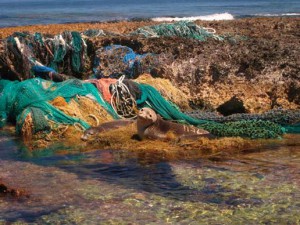Media Watch, Christopher Pala, Honolulu Weekly, 13 October 2010
Some folks made a killing depleting the Papahānaumokuākea Marine National Monument. Wait ‘til you see how much they’ll make not to fish there anymore.
 The news came innocuously enough, in a press release earlier this year from the National Oceanographic and Atmospheric Administration. As a result of former President George W. Bush’s designation of the Northwestern Hawaiian Islands as a marine national monument in June 2006, Congress appropriated funds to compensate the owners of seven bottomfish licenses and 15 lobster licenses because they would no longer be able to fish there. The bottom-fishermen would share $2.2 million, the lobster fishermen $4.3 million. All licenses had been given out for free. […]
The news came innocuously enough, in a press release earlier this year from the National Oceanographic and Atmospheric Administration. As a result of former President George W. Bush’s designation of the Northwestern Hawaiian Islands as a marine national monument in June 2006, Congress appropriated funds to compensate the owners of seven bottomfish licenses and 15 lobster licenses because they would no longer be able to fish there. The bottom-fishermen would share $2.2 million, the lobster fishermen $4.3 million. All licenses had been given out for free. […]
After two temporary closures by NOAA, the Honolulu federal court closed the fishery again in 2000 because of still-disputed evidence that the collapse of the lobster population had triggered mass starvation among monk seal pups, and that in turn caused a 5 percent yearly decline in the monk seal population. The fishery was never reopened, presumably because the lobster stocks never recovered, and the monk seal pups in the Northwestern Hawaiian Islands are still starving. […]


 The NOAA Ship Oscar Elton Sette is at sea for 19 days on a scientific expedition to support Pacific Islands Fisheries Science Center (PIFSC) staff studying monk seals in the remote Northwestern Hawaiian Islands (NWHI).
The NOAA Ship Oscar Elton Sette is at sea for 19 days on a scientific expedition to support Pacific Islands Fisheries Science Center (PIFSC) staff studying monk seals in the remote Northwestern Hawaiian Islands (NWHI). Jeff Walters is the Hawaiian monk seal recovery coordinator for NOAA Fisheries Service. Walters said that in the isolated northwest Hawaiian islands, the number of monk seals is declining by four percent every year. That’s the bad news. But the good news is that a smaller population of seals on the main Hawaiian islands is growing and thriving, he said.
Jeff Walters is the Hawaiian monk seal recovery coordinator for NOAA Fisheries Service. Walters said that in the isolated northwest Hawaiian islands, the number of monk seals is declining by four percent every year. That’s the bad news. But the good news is that a smaller population of seals on the main Hawaiian islands is growing and thriving, he said. With the help of the NOAA Ship Oscar Elton Sette, summer field camps for the annual assessment of Hawaiian monk seals in the Northwestern Hawaiian Islands (NWHI) were recently deployed by PIFSC at all major NWHI monk seal breeding locations.
With the help of the NOAA Ship Oscar Elton Sette, summer field camps for the annual assessment of Hawaiian monk seals in the Northwestern Hawaiian Islands (NWHI) were recently deployed by PIFSC at all major NWHI monk seal breeding locations.